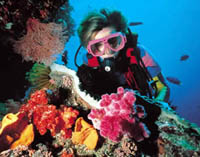On sensors and the Great Barrier Reef


So what?
This is the biggest sensor installation I've heard of to date (excepting the world's cell phone network, which senses the locations of hundreds of millions of unsuspecting customers), and it's yet another indication that distributed sensors are coming into their own.
Ocean-wise, we can look forward to a day when they're used to track currents, winds and temperature; keep tabs on the larger sharks; and detect the illegal "snap" of a diver breaking off a piece of coral. (Speaking of sharks, sensors could also be used to detect when a particularly large creature has invaded a swimming area and, in response, blast the "Jaws" theme over the PA system. Fun!) Perhaps the most personally useful seaside sensor technology: a small, shoulder-worn patch (similar to a dosimeter) that beeps when your sun exposure nears the safe maximum for the day. Back-of-the-envelope calculations by a fictional researcher in England indicate that such a device could be built for under £5.